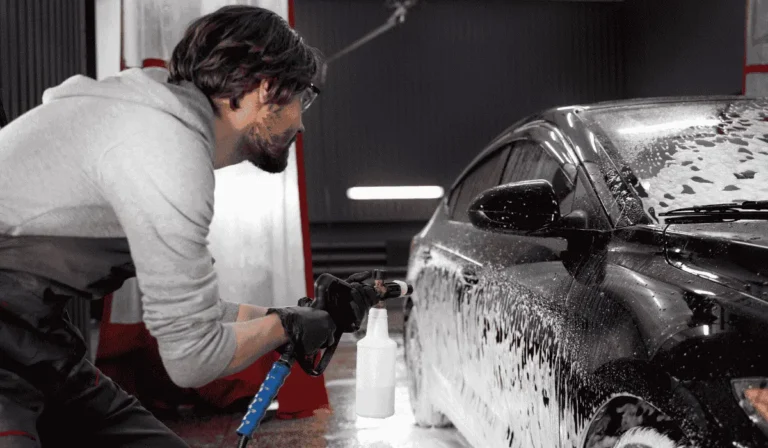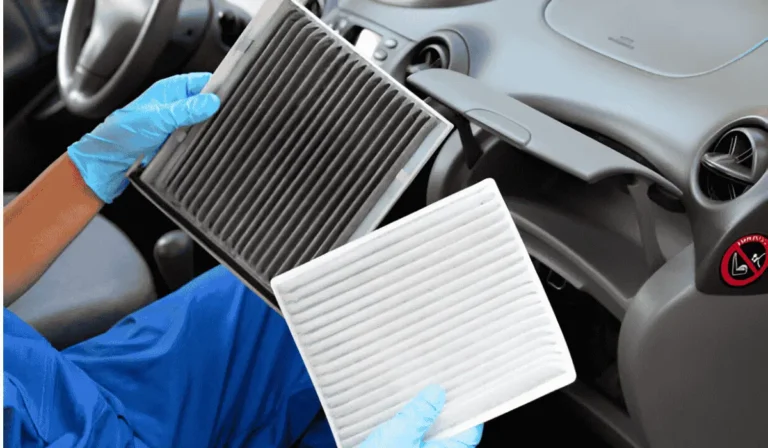Changing a tire usually takes 15 to 30 minutes if you have the right tools and know the process. But the exact time can vary depending on whether you’re doing it yourself, calling roadside assistance, or visiting a tire shop.
Want to know how long it takes in each situation and what can slow you down or speed things up? Keep reading for a full breakdown, expert tips, and a quick guide to changing a tire safely and efficiently.
Also, if you’re maintaining your vehicle regularly, don’t forget to check out how often to change your cabin air filter, a small but important part of your car’s health.
How Long Does It Take to Change a Tire? (Average Times Explained)
Changing a tire varies based on how it is being done. It also varies depending on where it is being changed. The procedure could take anywhere from 15 minutes to more than an hour.
It depends on some elements such as experience, tools, and external assistance. Here is a breakdown of what to anticipate in different frameworks:
At Home or DIY Tire Change
Whether you are changing a tire yourself at home or if you are on the roadside. It normally takes 15 to 30 minutes. It means you must have all the significant tools. These tools may include a jack, lug wrench, and a spare tire.
It also contains a basic understanding of the tire changing procedure. If they encounter complications such as lug nuts that are stuck and a jack that is not appropriately positioned, first-timers may take more time.
With Roadside Assistance
If you request roadside help, changing a tire can take 30 to 60 minutes. It depends on the response time. The actual tire change is very speedy, taking about 10–15 minutes.
The total time includes waiting for assistance to arrive. It is a suitable option if you are unsure about how to change a tire or if you don’t have the necessary tools.
At a Professional Tire Shop
Tire change waiting time in the shop is 30 to 45 minutes for a professional tire change, as wait times can expand the visit to over an hour, mostly during busy periods.
Experienced people can utilize advanced tools and lifts. That is why the actual process is quick and accurate. It is likewise the best choice for the tire replacements, and it puts it right beyond an easy spare installation.
How Long Does It Take to Change All Four Tires?
If you are changing all four tires, it takes more time than changing 2 tires. Moreover, if you change only one tire, then it will take less time. It depends on you whether you do it by yourself or whether you go to a professional. So, the total time may vary considerably.
DIY vs Professional Timeframes
If you change all four tires yourself, the procedure should take between one and two hours. It depends on your level of expertise. Additionally, it also depends on the kind of equipment you are utilizing.
Moreover, it also depends on how your workspace is set up. Without advanced tools, it takes a long time for the majority of people.
The average time to change a tire at a repair shop typically takes 45 minutes to 1 hour. The professionals utilize specialized tools such as hydraulic lifts and pneumatic tools.
These tools speed up the procedure significantly. Moreover, wait times can further expand your total visit time.
Factors Affecting the Duration
Different variables impact the duration to change four tires:
- Experience level: DIYers may take more time due to caution, setup, and learning curve.
- Tools available: A floor jack, torque wrench, and impact driver make the job much faster.
- Vehicle type: More vehicles or those with special lug nut patterns may take more tire replacement time.
- Tire condition: Worn or rusted parts can cause delays.
- Weather and lighting: Some circumstances can slow you down, mostly outdoors.
How Long Does It Take to Change 4 Tires and Get an Alignment?
It will take 1.5 to 2 hours if you are getting all four tires changed on your vehicle. Moreover, the wheel alignment can take 30 to 60 minutes. It depends on the schedule and tools of the shop. The accuracy and measurement required for alignment take more time.
All four tires must be changed skillfully in under an hour. Moreover, adding some services or doing it yourself can increase the time significantly.
Key Factors That Impact Tire Change Time
During the changing of a tire, the time varies considerably depending on different significant elements. It varies from the sort of vehicle you have to the instruments at your disposal. Every element can speed up the process, but at the same time, it can also slow down the procedure.
Type of Vehicle
One of the biggest factors that affects how long a tire change takes is the type of vehicle you’re working on. Not all vehicles are created equal when it comes to this task.
- Cars are generally the fastest to deal with. They’re lighter, have smaller tires, and sit lower to the ground. A typical DIY tire change on a car might take 15 to 25 minutes per tire.
- SUVs come with larger tires and more ground clearance. You’ll likely need sturdier tools, which can add 5 to 10 more minutes per tire.
- aTrucksre the most time-consuming. Their heavy-duty tires, extra lug nuts, and weight require more effort and sometimes specialized equipment, so the process can be significantly slower.
Type of Tire
Not all tires are created equal, and the type of tire you’re dealing with can significantly affect how long it takes to change it.
- All-season tires are the most common and generally the fastest to replace. They’re designed for everyday driving, so they’re lightweight, flexible, and easy to work with, perfect for a quick swap.
- On the other hand, performance tires or low-profile tires are more delicate. Their thinner sidewalls and tighter fit on the rim mean you have to be extra careful. One wrong move could lead to rim damage, which slows things down and might cost more in the long run.
- Then there are off-road and heavy-duty tires, which you’ll often find on trucks, SUVs, or utility vehicles. These tires are larger, heavier.
Tools Available
If you’re wondering how fast you can change a tire, your tools will answer that.
- A basic car jack and lug wrench will get the job done, but expect it to be a slow and physical process.
- A hydraulic floor jack and impact wrench can cut the time in half. These are commonly used in shops and by experienced DIYers.
- A torque wrench may slow you down slightly, but it’s essential for ensuring the lug nuts are tightened safely and correctly.
Pro tip: If you plan to do this yourself, invest in better tools; they make the job faster and safer.
Roadside Conditions
Changing a tire at home in your driveway? That’s the best-case scenario. The ground is flat, you’ve got space to move around, and everything feels a lot safer. But out on the road? It’s a different story.
If your car gets a flat on a slope, in gravel, or on soft dirt, even setting up the jack can be a hassle. You’re constantly trying to balance the car, keep your tools from slipping, and make sure you’re safe, especially if there’s traffic flying by.
Add in bad weather like rain or snow, and what should be a simple job becomes frustrating and slow.
Step-by-Step Tire Changing Process
Changing a tire is a very practical task when you follow the accurate steps. There are some factors you need to know. These factors may include everything from collecting the tools to getting them back on the road properly.
Essential Tools Needed
When you start, make sure you have the given elements:
- Spare tire (fully inflated)
- Car jack (hydraulic or scissor)
- Lug wrench or tire iron
- Wheel wedges or bricks (to stop rolling)
- Vehicle owner’s manual
- Flashlight
- Work gloves (optional but useful)
- Tire pressure gauge
Optional but useful:
- Torque wrench (for accurate lug nut tightening)
- Kneeling mat or tarp (for roadside use)
Safety Tips Before Starting
Security must always come first. Before lifting your vehicle, take the following precautions:
- Change your location to a safe, level spot away from traffic.
- Turn on hazard lights to warn other drivers.
- To prevent rolling, press the parking brake.
- Wheel wedges should be placed in front of or in the black of the tires that are experiencing an overall flat.
- For instructions specific to your vehicle, consult the owner’s manual.
- Never creep under the vehicle when it is supported only by a jack.
Step-by-Step Guide to Change a Tire
- Lift the vehicle with the jack: Adjust the jack beneath the manufacturer-suggested lift point a little closer towards the flat tire. Then elevate the vehicle as the tire is nearly six inches off the ground.
- Loosen the lug nuts: Utilize the lug wrench to loosen the lug nuts (but do not separate them yet). Turn anticlockwise.
- Remove the lug nuts and the flat tire: Finish removing the loose lug nuts and then place them in a safer location. Then, place the flat tire straight off the wheel bolts.
- Fully tighten the lug nuts: Utilize the lug wrench to secure the nuts fully in a crisscross or star pattern. Whether you have the torque wrench, tighten towards the suggested setting of the manufacturer.
- Check the tire pressure: Use a tire gauge to guarantee that the tire is accurately inflated. Modify as required.
- Stow your tools and flat tire: Keep all tools and the previous tire safely in the trunk.
By utilizing these methods, you will be ready to control most flat tire circumstances carefully and proficiently.
How to Speed Up the Tire Changing Process?
The question is, how long does it take to change a tire on the side of the road? Sometimes you really want to cut down or shorten the time it takes to change a tire.
Especially in a roadside emergency, preparation along with the right tools makes all the difference. Here are some of the practical techniques to make the procedure faster and more efficient.
Use of Automatic Tools
Investing in an automatic alongside the advanced tools can significantly decrease both the effort along time:
- Electric or battery-powered impact wrench – Speeds up the loosening along tightening lugs as nuts compared to any manual wrench.
- Hydraulic floor jack – Lifts your vehicle quickly with minimal effort, saving time over the standard scissor jacks.
- Torque wrench with preset settings – Guarantees proper tightness quickly without any guessing.
- Portable air compressor – Handy for inflating the spare tire on the spot if required.
All these tools decrease the physical strain. They also enhance the precision along with the speed of each step.
Pre-checks and Maintenance
Routine preparation can dramatically decrease the tire change time during any emergency:
- Keep your tools organized – Store them together, clearly labeled. Or save them in an easy-to-reach kit in your trunk.
- Check your spare tire monthly – Make sure that it is properly inflated and is in good condition.
- Practice changing a tire – Doing a dry run at home can familiarize you with the procedure, alongside identifying any missing tools.
- Inspect lug nuts – Make sure that they are not rusted or overly tight. Anti-seize lubricant can assist with this.
- Know your jack points – Refer to the manual of your owner so you are not searching under the car during any stressful situation.
By combining the solid preparation with the time-saving tools, you can confidently change the tire in less time, along with far less hassle.
Signs You Might Need a Tire Change Soon
Considering the early signs of tire wear, along with the damage, can help you avoid unexpected flats. It can also help with the dangerous driving conditions. Here is how to tell when it may be time for a tire replacement.
Visual Indicators
Inspect your tires daily for the following visual warning signs that involve:
- Low tread depth – Utilize the penny test or any tread depth gauge. If you can look at the top of the head of Lincoln, your tread is too low. It may be as low as less than 2/32 of an inch.
- Cracks and the dry rot – The minor cracks on the sidewalls and among the treads show the aging rubber. It can directly lead to blowouts.
- Bulges or bubbles – These can signal internal damage. They can also raise the risk of sudden tire failure.
- Uneven wear – Worn edges or bald spots may suggest alignment or suspension issues, and they reduce tire lifespan.
- Objects stuck in the tire – Nails, screws, or other debris can cause slow leaks or lead to sudden flats if not removed or repaired.
Performance-Based Signs
Changes in how your car drives can also indicate that your tires are near the end of their life:
- Poor traction – If your car slips alongside skids in wet conditions more easily. The tread might be too worn.
- Longer stopping distances – Worn tires can decrease the braking efficiency. It can do so, especially in bad weather.
- Vibration or thumping – This could exhibit tire imbalance, uneven wear, along internal tire damage.
- Pulling to one side – Often a sign of uneven tire wear and misalignment.
- Frequent air loss – If you are refilling your tires often, there could be a slow leak or sidewall damage.
Keeping an eye on all these signs can help you plan timely replacements. They also help to avoid emergencies, saving you time along money in the long run.
Can You Change a Tire Yourself?
Yes, you can change a tire completely by yourself if provided. You can do this if you have the proper tools, some basic knowledge, along a safe environment. While it is a valuable skill for any driver, it is not always the best option in any situation.
Pros and Cons of DIY
Pros:
- Saves time and money – No need to wait for assistance and pay for roadside service.
- Empowers self-reliance – You would not be stranded if you knew what to do.
- Convenient in remote areas – Helpful if the roadside assistance is unavailable and delayed.
- Good for minor issues – Quick fix if you have any small punctures alongside a spare tire.
Cons:
- Physically demanding – Needs lifting, kneeling, along manual effort.
- Can be unsafe in poor conditions – Nighttime, bad weather, and traffic-heavy roads pose serious risks.
- Limited by tools – If you lack any proper jack, wrench, or spare, you are stuck.
- May void tire warranties or cause damage – Improper tightening and lifting can lead to problems later.
When to Call a Professional?
Consider calling a professional for tire change service help in the situations given below:
- You do not have the right tools or a spare tire
- You are in a dangerous location, such as on a narrow shoulder or on any busy highway
- The weather is extreme – Rain, snow, and darkness make the DIY much riskier
- You are unsure about the process – Any mistake could lead to further damage and safety issues
- Tire damage is severe – Sidewall blowouts and the bent rims need more than a simple tire change.
How Long Does It Take to Fix a Flat Tire (Not Replace)?
Fixing any flat tire rather than replacing it can be a relatively quick process. It depends on the method utilized. It also depends on where the repair takes place.
On average, the professional repair can take about 15 to 30 minutes. While a temporary fix on the road may be completed in about 10 minutes or less.
Plug/Patching Time vs Total Replacement
If you are opting to repair the tire with any plug and patch, the time required is usually shorter than the time for replacing the entire tire:
- Tire Plug: This quick fix includes inserting the rubber plug into the puncture. It usually takes 10 to 15 minutes, specifically for small punctures.
- Tire Patch: A more durable solution that requires removing the tire from the rim, along with applying a patch on the inside. This technique takes 20 to 30 minutes.
Shop Repair vs Temporary Fix
Where the repair takes place can essentially affect the overall time:
- At a Tire Shop: Expect to wait for about 30 minutes to an hour. It depends on how busy the shop is. It also depends on whether you require an internal patch. Most shops will recommend a patch or any combination plug-patch for safety.
- Temporary Roadside Fix (e.g., Plug Kit or Sealant): If you are doing it all by yourself with a plug kit or any aerosol sealant, it could take 5 to 10 minutes. This time is just enough to get you to a service center. Although these are not permanent solutions, alongside might void your tire warranty if not followed up with any proper repair.
When Should You Replace vs Repair Tires
Multiple flat tires can be safely repaired. There are clear situations where replacement is the safer but sometimes only option. Here is how to choose:
Repair Your Tire If:
- The puncture is about ¼ inch (6mm) or smaller in the tread area.
- There is no sidewall damage.
- The tire has not been driven on while flat (which can disrupt the internal structure).
- The tire has not already been repaired many times in the same area.
Replace Your Tire If:
- The damage is on or near the sidewall. Or it is in the shoulder.
- The puncture is bigger than ¼ inch.
- The tire has a blowout, deep gash, or any visible cords.
- There is internal structural damage from driving on it flat.
- The tread is worn down over the legal minimum (typically about 2/32 of an inch).
Conclusion
Changing and fixing a tire does not have to be a major hassle. If you are just fixing a small puncture, you may be back on the road in about 15 to 30 minutes. How long does it take to change tires at Costco?
A full tire change takes a bit longer. It typically takes 30 to 60 minutes at a shop, or 10 to 20 minutes if you are swapping it with any spare parts yourself. The basic key is knowing what kind of tire issue you are dealing with. You must also know whether a repair or replacement is the right call.
And if you’re working on your car, it’s also worth learning can I wash my car after tint to ensure your window film stays in top condition. With the right tools and professional help, even a flat tire becomes just a minor detour and not a disaster.
FAQ’s
Can I change a tire in 15 minutes?
Yes, if you have the right tools along with some experience, changing a tire can take as little as 10 to 15 minutes. This usually applies to installing a spare and a donut tire. For the beginners, expect closer to about 20–30 minutes.
Is it safe to drive on a spare tire?
Yes, but only for short distances at decreased speeds. Most spare tires (especially donuts) are rated for speeds up to 50 mph (80 km/h). They should not be driven more than about 50–70 miles. Full-size spares can go longer, but should still be checked alongside being inflated properly.
How long should it take a shop to change 4 tires?
On average, the professional tire shop can change 4 tires in 45 minutes to an hour. Busy times and added services (such as alignment) might extend the wait.
How often should tires be rotated?
Tires should usually be rotated about every 5,000 to 7,500 miles, or as suggested in your vehicle’s manual of owner. Regular rotation guarantees even wear and assists in extending the life of your tires.
















